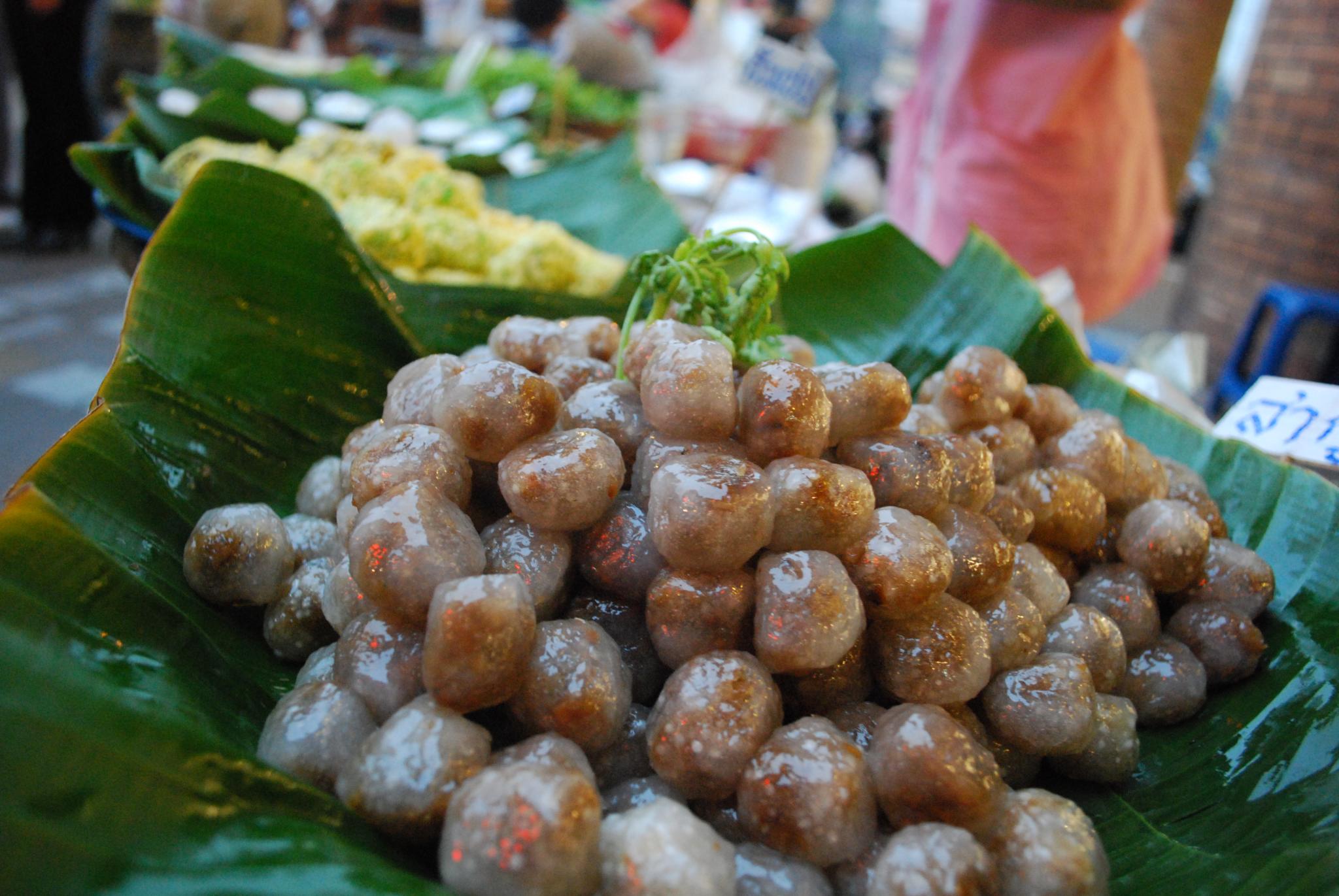|
Sakhu Sai Mu
Sakhu sai mu ( th, สาคูไส้หมู, , "tapioca balls with pork filling") is a Thai snack. Although it is traditionally made with sago starch (hence the name ''sakhu'', which is Thai for sago), today tapioca is more commonly used as a substitute. It is a popular food in Thailand and found at street stalls and markets. ''sakhu sai mu'' is a dumpling which consists of a flour ball with a pork filling. Most people in Thailand eat ''sakhu sai mu'' with ''khao kriap pak mo''. The difference between ''sakhu sai mu'' and ''khao kriap pak mo'' is that sakhu sai mu is covered with flour batter like a dumping while ''khao kriap pak mo'' is wrapped with flour batter. They have the same filling. The ingredients of ''sakhu sai mu'' are tapioca flour, cilantro, finely chopped onion, lean pork finely chopped, brown sugar, Thai fish sauce, finely chopped fresh hot chilies and roasted peanuts. See also * List of stuffed dishes This is a list of stuffed dishes, comprising dishes an ... [...More Info...] [...Related Items...] OR: [Wikipedia] [Google] [Baidu] |
Thai Cuisine
Thai cuisine ( th, อาหารไทย, , ) is the national cuisine of Thailand. Thai cooking places emphasis on lightly prepared dishes with strong Odor, aromatic components and a spicy edge. Australian chef David Thompson (chef), David Thompson, an expert on Thai food, observes that unlike many other cuisines, Thai cooking is "about the juggling of disparate elements to create a harmonious finish. Like a complex musical chord it's got to have a smooth surface but it doesn't matter what's happening underneath. Simplicity isn't the dictum here, at all." Traditional Thai cuisine loosely falls into four categories: ''tom'' (boiled dishes), ''yam'' (spicy salads), ''tam'' (pounded foods), and ''kaeng'' (curries). Deep-fries, stir-fries, and steamed dishes derive from Chinese cuisine. In 2017, seven Thai dishes appeared on a list of the "World's 50 Best Foods", an online poll of 35,000 people worldwide by ''CNN Travel''. Thailand had more dishes on the list than any other co ... [...More Info...] [...Related Items...] OR: [Wikipedia] [Google] [Baidu] |
Sago
Sago () is a starch extracted from the pith, or spongy core tissue, of various tropical palm stems, especially those of ''Metroxylon sagu''. It is a major staple food for the lowland peoples of New Guinea and the Maluku Islands, where it is called ''saksak'', ''rabia'' and ''sagu''. The largest supply of sago comes from Southeast Asia, particularly Indonesia and Malaysia. Large quantities of sago are sent to Europe and North America for cooking purposes. It is traditionally cooked and eaten in various forms, such as rolled into balls, mixed with boiling water to form a glue-like paste ( papeda), or as a pancake. Sago is often produced commercially in the form of "pearls" (small rounded starch aggregates, partly gelatinized by heating). Sago pearls can be boiled with water or milk and sugar to make a sweet sago pudding. Sago pearls are similar in appearance to the pearled starches of other origin, e.g. cassava starch (tapioca) and potato starch. They may be used interchang ... [...More Info...] [...Related Items...] OR: [Wikipedia] [Google] [Baidu] |
Tapioca
Tapioca (; ) is a starch extracted from the storage roots of the cassava plant (''Manihot esculenta,'' also known as manioc), a species native to the North Region, Brazil, North and Northeast Region, Brazil, Northeast regions of Brazil, but whose use is now spread throughout South America. It is a perennial shrub adapted to the hot conditions of tropical lowlands. Cassava copes better with poor soils than many other food plants. Tapioca is a staple food for millions of people in tropical countries. It provides only carbohydrate food value, and is low in protein, vitamins and Mineral (nutrient), minerals. In other countries, it is used as a thickening agent in various manufactured foods. Etymology and origin ''Tapioca'' is derived from the word ''tipi'óka'', its name in the Tupi–Guarani languages, Tupi language spoken by natives when the Portuguese first arrived in the Northeast Region of Brazil around 1500. This Tupi word is translated as 'sediment' or 'coagulant' and refe ... [...More Info...] [...Related Items...] OR: [Wikipedia] [Google] [Baidu] |
List Of Stuffed Dishes
This is a list of stuffed dishes, comprising dishes and foods that are prepared with various fillings and stuffings. Some dishes are not actually stuffed; the added ingredients are simply spread atop the base food, as one cannot truly stuff an oyster or a mussel or a pizza. Stuffed dishes * A-gei * Apam balik * Arancini * Arem-arem * Badrijani * Bakpia Pathok * Ballotine * Bánh bao * Bánh chưng * Bánh lá * Bánh tét * Bánh xèo * Barbajuan * Bhendi fry * Bichak * Blini * Bolani * Boliche * Börek * Botillo * Cachopo * Carimañola * Carpetbag steak * Chả giò * Chatti pathiri * Chaudin – a meat dish from southern Louisiana, it is a sausage-like variant made from ingredients such as spices, pork, rice and vegetables that are sewn up in a pig's stomach, which is then cooked. The dish is sometimes smoked. * Chebureki * Chicken Kiev * Chile relleno * Chiles en nogada * Cordon bleu * Crappit heid – a traditional Scots fish course, consisting of a boil ... [...More Info...] [...Related Items...] OR: [Wikipedia] [Google] [Baidu] |

_in_New_Guinea.jpg)
